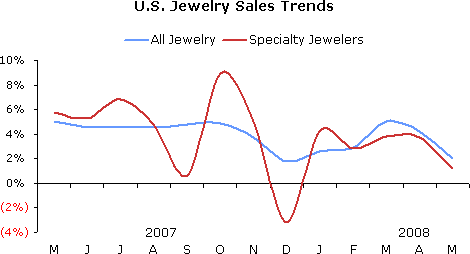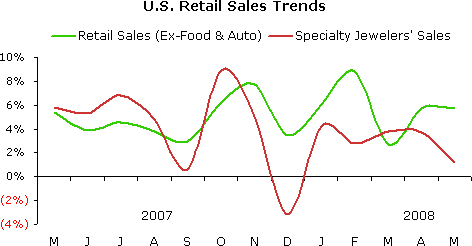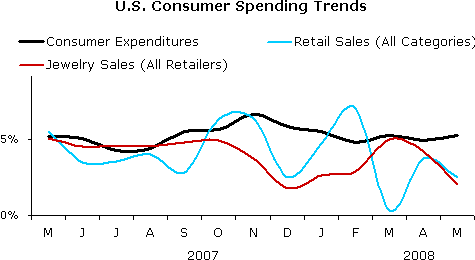IDEX Online Research: U.S. May Jewelry Sales Listless
July 17, 08
After limping along for several months, jewelers in the U.S. market were looking forward to Mother’s Day in May. This important calendar event was supposed to be an excellent opportunity for merchants to boost their sales. Unfortunately, it did not happen. Jewelry sales, both for the total product category and for U.S. specialty jewelers, rose by the smallest amount so far this year.
In fact, the malaise that affected consumer spending for jewelry also affected overall retail sales trends, especially for big ticket items. While retail sales for all categories except food and automobiles were relatively stable, when autos are added, retail sales trends were decidedly weak. Here are the key figures for May consumer demand trends and retail sales.
- +2.0 percent - Total U.S. Jewelry Sales
- +1.2 percent - Total U.S. Specialty Jewelers’ Sales
- +2.5 percent - Total U.S. Retail Sales (All Categories)
- +5.7 percent - Total U.S. Retail Sales (Ex-Auto & Food)
The table below summarizes the past three months’ trend for key retail sales figures:
 Source: Various |
Here’s the good news in the May figures. Based on historical correlations between economic sluggishness and jewelry demand, jewelry sales in 2008 are holding up remarkably well. Normally, we would have expected jewelers to be posting consistent negative sales comparisons by now.
In part, this may be due to jewelry price inflation at the retail level. Since the mid-1990s, there has either been no inflation or some deflation in retail jewelry prices. This year, however, retail jewelry price inflation has reached as high as 9 percent (we are predicting 7 percent retail jewelry price inflation for the year). Thus, 2008 has been an unusual year with rampant jewelry price inflation. When inflation is removed from the reported numbers (we report “dollars through the cash register” – that’s the colloquial name for what economists call “current dollars”), jewelry unit sales were down more than 6 percent in the month of May.
Sales Patterns Unchanged from Prior Months
Jewelers tell us that some tactics are successful to entice customers into their stores, but other tactics simply don’t work. Here’s what we are hearing.
Consumers want:
- High-quality merchandise
- Fashion-forward merchandise
- Brand-name goods
- Custom jewelry
- High-end timepieces
- Designer jewelry
- Colored gemstone jewelry
- Bridal jewelry
Consumers aren’t reacting to:
- Price-based promotions that are too good to believe
- Commodity goods
- Aggressive sales techniques
It is clearly a buyer’s market for jewelry. Jewelers have found that consumers will react positively to a discount offered in the store, but ads that scream “super-duper discounts today only” not only put off customers, but reduce their confidence in jewelers.
Outlook Cautious; Forecast Unchanged
Our outlook for U.S. jewelry sales remains cautious for the year. Whether or not we are in a “technical recession” – defined as two consecutive quarters of a decline in Gross Domestic Product – or just in a “mental recession,” with consumers tightening their purse strings, the fact is this: retail spending has slowed notably, especially in May.
Earlier this year, we raised our full-year jewelry sales forecast to +3 percent from our prior forecast of +1-2 percent (point estimate was about +1.4 percent). Why? Jewelry price inflation at the retail level appeared to be enough to push sales up by 3 percent. However, based on May’s sales gain of only 2 percent for the total industry and 1.2 percent gain for specialty jewelers, the year-to-date sales gain is running at 3.3 percent for the total industry and only 3.0 percent for specialty jewelers.
We had expected that the economy would move through its rough patch in the first half of 2008, and show a modest recovery in the second half of the year. The prospects for this recovery look less likely now.
We aren’t changing our forecast yet, but it is likely that any adjustment would be downward.
May Jewelry Sales Show Modest Gain
The total market for jewelry in the U.S. grew by only a 2.0 percent rate during May. The month of May has one of the three key annual selling periods for jewelers: Mother’s Day. Unfortunately, jewelry demand for consumers’ mothers was very weak. This does not bode well for the next few months, when there are no major calendar events that would normally provide a boost for jewelry demand.
Specialty jewelers in the U.S. market eked out a modest sales gain of 1.2 percent over the same month a year ago, down significantly from last month’s adjusted sales increase of 3.7 percent. Unfortunately, though, these figures confirm once again that specialty jewelers lost market share in May versus their competition from non-traditional sources of jewelry such as discounters, mass marketers and others.
Further, the jewelry industry lost market share when compared to other retail categories. Total retail sales (all goods, including food and automobiles), were up (+2.5 percent) in May. Total retail sales, except food and automobiles, rose by a solid 5.7 percent in May. Thus, the jewelry industry – and specialty jewelers – lost market share during the month.
The graph below compares specialty jewelers’ sales trends (red line) to total jewelry sales trends (blue line) in the U.S. market. As the graph clearly illustrates, jewelry sales at specialty jewelers have been on a roller coaster ride for the past few months, with a sharp slide in September, a spike in October, another slide in November and December, followed by a modest recovery in January, a dip in February, and a modest recovery in March and April. In May, jewelry sales gains weakened substantially.
 Source: US Dept. of Commerce |
The graph below summarizes sales trends for all retail goods (green line) excluding food and automobiles versus specialty jewelers’ sales (red line). When food and auto sales are excluded, the remaining retail categories posted a sales gain of 5.7 percent in May. When food and auto sales are included, retail sales were up 2.5 percent for the month, as previously indicated.
|
|
Why do we eliminate “automobile” sales? Monthly auto sales are driven largely by consumer incentives rather than by underlying economic factors. Over the long term, auto demand trends are an important indicator of consumer vitality; however, on a month-to-month basis, auto demand is dependent on manufacturers’ incentives such as zero percent financing, cash-back offers, and other deals. Food sales are far less cyclical and can mask changes in consumer demand; thus, we eliminate them, too.
Consumer Spending Was Steady in May
Driven by price inflation of core commodities such as gasoline and food, consumer expenditures rose by 5.2 percent during May 2008, up slightly from April and about flat with March’s performance. In March, we had seen a hopeful modest uptick in consumer spending. However, when consumer spending trends are viewed over the past several months, the trend is decidedly slowing (black line on graph below). Spending on services remains more-or-less on track, with little monthly deviation.
The graph below summarizes trends in American’s total spending (black line), retail sales of all goods (blue line) and expenditures on jewelry (red line). It is clear that dismal automobile sales in the U.S. market are having a dramatic negative impact on total retail sales (blue line). Automobile sales in 2007 were just over 20 percent of total retail sales; thus, it is clear why they have such an impact on total retail sales trends. And, it should be obvious why we typically eliminate them, when we analyze U.S. retail sales. Automobile sales are driven largely by the “deal-of-the-day,” as we noted above.
|
|
2008 Jewelry Sales Forecast Unchanged
While the economy is not technically in a recession – first quarter economic growth was anemic, but still slightly positive – consumers are in a mental recession. As a result, jewelry demand is soft.
But there is something else going on that we haven’t seen in more than a decade: rampant inflation in the jewelry industry. Precious metals prices have risen steeply, and polished diamond prices are up sharply this year. Those higher costs are finally finding their way though to retail prices. During March and April, retail jewelry prices in the U.S. market were up in sharply. In May and early June, we saw even more jewelry price increases at retail.
As a result of inflationary pressures, our jewelry sales forecast for the U.S. calls for a +3 percent gain for 2008. We continue to believe that specialty jewelers will report sales slightly in excess of this gain, while multi-line retailers who sell jewelry will likely experience smaller gains, though current trends would suggest otherwise. There is one important note: all jewelers are expected to sell fewer pieces of jewelry (if inflation remains in the 8-9 percent range, it means that unit sales of jewelry will be down 5 percent or so); further, we are assuming that the average ticket doesn’t move much.
Finally, we are expecting customer traffic to be down modestly, but the conversion rate should rise. Why will the conversion rate rise? If jewelers help their sales people do their job, fewer browsers will walk away without buying anything.

